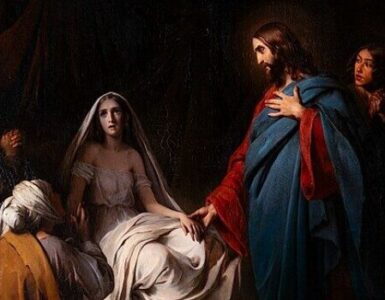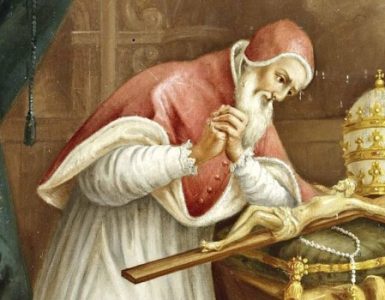Out of necessity, humans have latched onto dating systems and chronologies as the means by which we keep track of ourselves in time. We keep track of where we are through our age, by the face of a clock, by naming generations, and by counting centuries and millennia. How often have you thought about this system by which we tell time? The one universal dating system upon which governments, business, travel, and education are based reigns supreme today, measuring years according to Common Era (CE) and Before Common Era (BCE) to provide a common reference for time. But did you know that there have been many kinds of dating systems preceding this one? What’s so important about this one that made it stick?
In a word: the Incarnation. The moment God became man and the entirety of salvation history was forever changed. Time as we measure it today is linked to a religious, a supernatural event: the birth of God become man, the nativity of the Son of God, the act of the Word becoming flesh, the Incarnation of Christ, the arrival of the Messiah.
The Gospel of Matthew records the birth of Jesus as occurring toward the end of the reign of Herod the Great, King of Judea, who died in the year 4 Ante Christos/Before the Common Era. The dating systems used at this time in the Roman Empire were Roman and Greek. According to the former, the Roman system, Jesus of Nazareth was born about 749–751 a.u.c. (ab urbe condita, from the legendary founding of Rome by Romulus and Remus). According to the Greek dating system, Jesus of Nazareth was born at the end of the 193rd Olympiad or beginning of the 194th Olympiad (an Olympiad having occurred every four years since its founding almost 770 years before)—in short, 6–4 Ante Christos/Before the Common Era.
Luke, who professes at the beginning of his Gospel to give his readers an accurate and complete story of the life of Jesus, provides two different accounts of Jesus’s birth that result in two contradictory dates. Like Matthew, Luke, in chapter one, uses episodic accounts, bringing into his narrative the stories of the visits of the angel Gabriel to Zechariah, father of John the Baptist, and Mary, mother of Jesus. According to these stories, Jesus was born six months after the birth of John the Baptist, which occurred near the end of the reign of King Herod, conforming with Matthew’s dating system. Unlike Matthew, however, Luke’s account in chapters two and three also provides chronological facts by which to date the birth of Jesus. Luke’s Gospel implies simultaneity to several events: the creation of the province of Judea by the Romans after almost a half century of rule by Herod and Herod Archelaus; Augustus Caesar’s ordering of a census; the subsequent rebellion of Judas of Galilee; and the appointment of Quirinius as Governor of Syria. Luke’s system of dating according to simultaneous public events is as sophisticated as those of the best Roman historians of the first century. According to Luke, Jesus was born in 760 a.u.c. or two years after the 196th Olympiad (i.e., 6 Anno Domini/Common Era).
The problem facing chronologers, besides the contradictions in the Gospels of Matthew and Luke and the lack of an account of Jesus’s birth by the other two Gospel writers, Mark and John, was that ancient historians and scientists disagreed upon which chronological system to use to date events. The great Athenian historian, Thucydides, relied on the reigns of Spartan ephors and Athenian archons to provide dates in his account of the Peloponnesian War. The Greek historian Polybius in his Histories used the more accurate and (from the standpoint of the Greeks) universal dating system of the Olympiads. The Roman historians Livy, writing during the reign of Augustus, and Tacitus, writing about a hundred years later during the reign of Domitian, used, besides the Olympiads, the system of dating events from the founding of the city of Rome (ab urbe conditia). In subsequent centuries, however, Christian writers, unwilling to rely on pagan dating systems, wished for a chronological system based on religious events.
Eusebius of Caesarea, writing during the reign of Constantine, added to the pagan dating systems and the chronology of Josephus a hypothetical chronological scheme beginning with the birth of the Patriarch Abraham. Yet three hundred years after the Incarnation, Eusebius still struggled to date the birth of Christ.
During Eusebius’ time, the Church and Empire, after its conversion under Constantine, were particularly concerned with dating the Resurrection. Theologians and chronologers used Greek, Roman, and Hebrew dating systems, until Dionysius Exiguus, in the sixth century, tried to base the reckoning of the dates of Easter not according to the older systems, rather according to a new system based on the greatest event in human history, the Incarnation of Christ. He used Luke 3:1 (John the Baptist appeared during the 15th year of the reign of Tiberius, 28–29 AD) combined with Luke 3:23 (Jesus was about 30 years old when he began his ministry), to estimate the year 1, meaning the first year or the year of our Lord, Anno Domini.
There is also the system of time developed by Aurelius Augustine, or St. Augustine, which is a method of understanding the temporal significance of Jesus’ birth that eschews reliance upon dating systems both ancient and modern. Augustine realized that the Incarnation and Resurrection cannot really be understood according to reason and logic, the stuff upon which chronologies and dating systems are based. Augustine developed another way (other than narrative, chronological history) to understand the Incarnation and its significance that eschews precise dating.
In Confessions, Augustine provided a model of personal time that provides each person with a model of the individual experience of the life and significance of Christ that has little to do with formal chronologies, history, and public events. It depends upon the old Greek idea of the Logos as developed by Philo Judaeus of Alexandria and the Apostle John. Philo wrote of the Logos: God creates “at once, not merely by uttering a command, but by even thinking of it” (Philo, n.d., III.13). And John wrote, “In the beginning was the Word, and the Word was with God, and the Word was God” (Jn 1:1).
Logos simply exists at all times but by taking on flesh enters into time, interacts with time, bringing light into time, whereas before there was only darkness. Darkness, time, yields to lightness, eternity. Ignorance yields to knowledge. Time is darkness because we cannot see what lies ahead. The future is unknown, and the past a memory. The present is a brief momentary anticipation of what might be. But if light enters darkness, if timeless enters time, then the path forward is brightened, made aware to us, lighting the way in the darkness. The future, always dark, is opened to light, and complete ignorance gives way to some knowledge of what will be. Not what might be. Because the night implies ignorance, implies that we are still guessing based on experience. No, now we know what will be thanks to the light.
All cultures have struggled to know the Logos. Polytheistic peoples conceived of a divinity that was inherent in nature, controlling all things, encompassing past, present, and future. The Hebrews identified it as Yahweh. The Greeks as the mind, the infinite, the good—the Logos. Asian philosophy called it the Way, the source, the Brahma. Christianity offers a unique perspective, that of a Transcendent Being that acts in time without being confined by it, acting subtly upon the self, connecting the self to the transcendent—a direct physical and spiritual connection.
As for me in my teaching and writing, I prefer to stay with Ante Christos and Anno Domini (BC/AD, not BCE/CE)—for how can time be truly understood without the Incarnation, the Logos becoming flesh?
Photo by Marek Piwnicki on Unsplash
Philo. (N.d.) The Works of Philo: On the Creation. Early Christian Writings. https://www.earlychristianwritings.com/yonge/book1.html.
John 1:1 NRSV-CE










